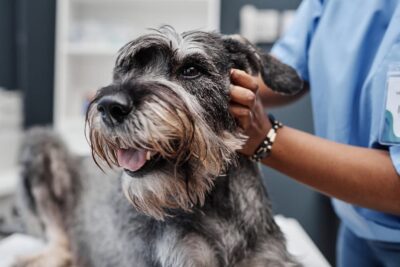8 Common Dog Skin Allergy Signs to Watch For

Skin allergies are incredibly common in dogs and lead to excessive itching and discomfort. Left untreated, they can progress in severity and result in secondary skin infections. Pet parents should know the signs of dog skin allergies so they can see a veterinarian for an accurate diagnosis and help their pets feel better quickly.
Dog Skin Allergies: Understanding the Basics
Dog skin allergies are similar to allergies that affect people. When a dog is exposed to an allergen, their body reacts by releasing proteins called cytokines. This results in an inflammatory reaction causing itchy skin. Skin allergies in dogs are most commonly due to the following:
- Flea allergy dermatitis: When a flea bites a dog, its saliva triggers a hypersensitivity reaction, leading to itchy, red skin. This most commonly affects the tail base, under the chin, and in the groin.
- Environmental allergens: Substances, such as grass and pollen, can result in itchy, inflamed skin in dogs. The most commonly affected areas include the belly and paws.
- Food: When dogs are allergic to a specific ingredient in their food (usually protein), they can experience itchy skin, watery eyes, and sometimes gastrointestinal signs, such as vomiting. Dogs with food allergies typically have itchiness in the ears and around the tail base.
Certain breeds are more prone to skin allergies, including Bulldogs, Golden Retrievers, Boxers, and Boston Terriers, just to name a few.
Skin allergies can negatively impact a dog’s quality of life due to the discomfort and itchiness they cause. Symptoms can be managed with medications, such as Elanco’s new treatment option called Zenrelia (ilunocitinib tablets), to help dogs feel better and improve their overall well-being. In some cases, dietary changes are necessary to improve symptoms as well.

Read the entire package insert before using Zenrelia, including the Boxed Warning.
8 Dog Skin Allergy Signs to Watch For
Signs of skin allergies in dogs may include the following:
Excessive itching, licking, scratching
Allergens cause irritation of the skin, so dogs commonly scratch, chew, and lick themselves. The most commonly affected areas include the ears, belly, and paws.
Skin odor
Because dogs with allergies often get secondary bacteria or yeast infections on their skin, they can start to smell musty.
Hair loss
When dogs repeatedly chew or scratch their skin, it causes trauma to the hair follicles, leading to bald patches throughout their fur.
Thick, leathery skin
Repeated trauma to the skin and underlying skin infections can result in thickened skin that looks similar to that of an elephant.
Redness, bumps, scabs
If a dog has skin allergies, they may develop superficial pyoderma, which is a skin infection that results in tiny bumps and scabs throughout their coat.
Ear discharge
Dogs with skin allergies commonly have concurrent ear infections. Their ears contain dark-colored discharge, have an odor, and are itchy.
Eye discharge
Similar to people, when dogs have allergies, their eyes can water and become red.
Nose discharge, sneezing
Dogs may sneeze and have thin, watery nose discharge if exposed to an allergen.
What to Do If You Suspect Your Dog Has Skin Allergies
If you suspect your dog has skin allergy symptoms, it’s important to see a veterinarian for an accurate diagnosis. Allergies will progressively worsen and cause significant discomfort for your dog if left untreated.
It can be helpful for pet parents to keep a journal noting when their dog’s symptoms are most prevalent and if they are correlated to exposures to certain household or environmental allergens.
Since allergies can appear similar to other skin conditions, such as mange, the veterinarian will want to perform testing to first rule out other causes for the dog’s symptoms. Pet parents can expect their veterinarian to do any of the following tests:
- Flea comb: A fine-toothed comb is used to brush the dog’s coat to identify live fleas or flea dirt (feces).
- Skin scrape: A dull blade is used to gently scrape an affected area of skin onto a glass slide containing a drop of oil. It is viewed under the microscope to identify live mites.
- Tape prep: A clear piece of tape is pressed against the affected area of skin, stained with dye, and viewed under the microscope to detect bacteria and yeast, which cause infection.
- Bloodwork: A sample of blood is collected from the dog to check for antibodies against specific allergens.
- Intradermal skin testing: Small samples of allergens are injected just underneath the dog’s skin while they are sedated. If the area swells up, it indicates an allergy.
Dog skin allergies treatment can be difficult, and pet parents should understand it may take several tries to find the best option for their dog. In my experience, antihistamines do not work well for dog allergies (like they do in people), but several other medications are highly effective at improving a dog’s comfort and quality of life while restoring their skin and fur back to normal.
A new oral medication called Zenrelia was recently FDA approved to treat allergic and atopic dermatitis in dogs. It is given once daily by mouth to control itching related to allergies, and studies have shown promising results. If you have a dog with skin allergies, ask your veterinarian if Zenrelia may be a good fit for your pet.

Read the entire package insert before using Zenrelia, including the Boxed Warning.
Additionally, regular bathing and wiping a dog’s paws after going outside can remove a large source of allergens from their skin and coat that could trigger a flare-up. Keeping your dog on year-round flea and tick medication can prevent parasites from wreaking havoc on your dog’s skin which can lead to uncomfortable allergies.
The earlier allergies are identified and treated, the better quality of life for your dog. If you suspect your dog has skin allergies, schedule a veterinary appointment promptly for a proper diagnosis.









